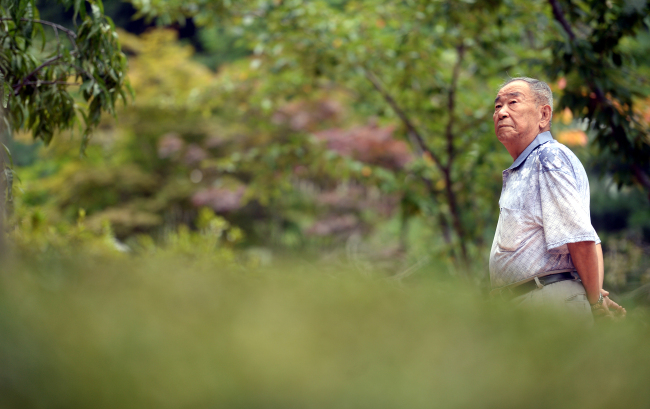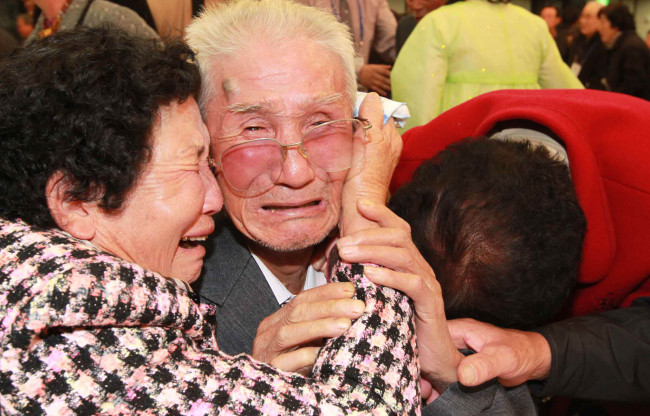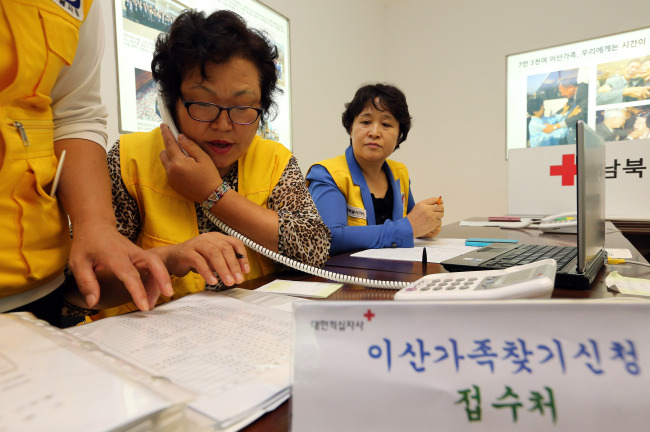60 years’ longing to reunite
National division, war leave only selected families with one-time chance to meet again
By Korea HeraldPublished : Sept. 13, 2013 - 20:36
Feisty and ambitious, a 21-year-old Kim Myung-do crossed the border to the South to fulfill his dream of studying literature and becoming a writer.
He never thought his choice would see him separated from his whole family for over 60 years. Not a single day has passed without guilt, remorse and longing for the loved ones he left behind in North Korea.
“I feel so sorry that I came down alone. They must have gone through enormous hardships,” Kim, now 89, said during an interview at his home in Yongin, Gyeonggi Province.
He never thought his choice would see him separated from his whole family for over 60 years. Not a single day has passed without guilt, remorse and longing for the loved ones he left behind in North Korea.
“I feel so sorry that I came down alone. They must have gone through enormous hardships,” Kim, now 89, said during an interview at his home in Yongin, Gyeonggi Province.

The retired editor is among 250 South Korean preliminary candidates for the first family reunions in three years.
Only 100 from each side will be picked to take part in the meeting at the Mount Geumgangsan resort on the North’s eastern coast from Sept. 25-30.
Kim had lived with his grandparents, parents and six younger brothers and sisters in the southern county of Eunyul in North Korea.
“Since then I’ve never heard from them,” Kim said, his eyes welling up with tears.
He is desperate for a chance to say sorry and catch up on lost time with his ill-fated family.
“I greatly missed them but the pressing issue at hand was that I had no means of livelihood,” Kim recalled.
Alone and empty-handed, the literary aspirant managed to fend for himself thanks to his writing talent.
He studied Korean literature at a university, taught at a middle school, and then became an editor at Minjung Publishing Co., which issued the nation’s first English-language dictionaries. He was vice president when his company was sold off amid financial difficulties in 1979.
Throughout more than 60 years, his old memories of his loved ones have never faded. But hopes for an ultimate reunion are waning as the prospect of reunification of the two Koreas looks increasingly dim.
“With a reunification appearing remote and myself aging, I fear that I will not be able to see them again,” he said.
Kim’s tragedy is shared by nearly 72,500 South Koreans who were torn apart from their families by the 1950-53 Korean War.
The fratricidal conflict ended in a truce, not a peace treaty, leaving the two sides technically at war and the families without communication and knowledge of each other’s fates.
Lee Joon-koo, 81, vividly remembers the day when she parted with her family in her hometown Gaepung in North Hwanghae Province.
It was a summer day but Lee’s mother had her wear thick clothes.
“I was standing in front of the house before departing. It was July though it was a bit chilly. My mother looked at me dressed in short sleeves. She quietly scolded me and dressed me warmly,” she said in a phone interview.
For all of her life since, she has appreciated her discrete mother: the warm clothes helped her endure the harsh winter of the year she spent alone in the South.
At age 19, she followed the steps of her father who had gone south first in the so-called Jan. 4 retreat in 1951, when South Korean and American troops backed off in the face of Chinese troops fighting for North Korea. But her mother and four younger siblings remained behind.
“I have been feeling guilty for all my life for abandoning my old mother. I had thought it would be only for a little while. If I had known it was forever, I would have never left,” Lee said.
“I want to seek forgiveness from my brothers and sisters, though some of them may not remember me.”

Since 2000, the divided states have organized 18 rounds of face-to-face reunions of the separated families as well as seven video-link meetings.
More than 22,000 people from 4,320 families have been reunited so far, mostly around major holidays such as Aug. 15 Liberation Day and Chuseok.
The humanitarian project was halted in 2010 in the wake of the North’s sinking of a South Korean corvette and artillery firing on a border island in the West Sea that same year.
For any of the 100 elderly finalists to be picked Monday, the upcoming reunions may be a once-in-a-lifetime opportunity.

According to the Unification Ministry, only 72,491 of the 129,035 South Koreans registered for family reunions since 1988 remain alive as of Aug. 31.
Of the survivors, 9.1 percent were aged over 90, 40.3 percent were in their 80s, 30.7 percent in their 70s and 11.5 percent in their 60s.
Like most of them, Jin Seung-joon, 93, does not know whether his younger brother is alive or not.
“I cannot say a word if I think of my brother,” said Jin, who hails from Daedong County, South Pyeongan Province.
Jin was 30 years old when he crossed the border during the massive retreat of early 1951, leaving behind his only family member, his brother 15 years his junior.
He was selling rubber shoes at a local marketplace after finishing middle school.
“One day people told me evacuate, saying the city would soon be hit by an atomic bomb,” he said.
“And I have come this far, knowing nothing about whether he survived, died from hunger, or got pushed to the countryside for work.”
With two brothers and one sister in the North, 81-year-old Jang Choon has yet to give up on his lifelong dream of holding their hands again. He left his home in Gyeongseong County, North Hamgyeong Province, to join the North Korean army in late 1950 at age 19.
“The youngest one was 10, so their memories of me could still be alive as we used to go to the sulfur springs near our neighborhood, which was one of the eight scenic spots in the Mount Geumgangsan area,” he said.
“I would love to go there again when the two Koreas are reintegrated. But before that, I am desperately hoping that we can visit each other at times or send letters at least.”
The separated families are becoming an ever more pressing issue because of their old age and weakening health. Some cannot travel to the North, opting for video meetings.
Joo Hak-yong, 87, gave up his chance to reunite with three younger brothers due to failing health though he made it to the 250 candidates.
Coming from Seoheung County, North Hwanghae Province, he is now waiting for a video meeting, which will take place for 40 families from each side on Oct. 22-23.
“I want to hear about how they have eked out a living ever since and how the situation is right now. I want to tell them to hope for a reunification so that we can see each other,” Joo said in a quavering voice.
“With the two Koreas’ relationship getting better, the Gaeseong industrial park will reopen soon, the Mount Geumgangsan tours will restart, and then the path to unification will open eventually.”
By Shin Hyon-hee (heeshin@heraldcorp.com)
-
Articles by Korea Herald







![[Graphic News] More Koreans say they plan long-distance trips this year](http://res.heraldm.com/phpwas/restmb_idxmake.php?idx=644&simg=/content/image/2024/04/17/20240417050828_0.gif&u=)
![[KH Explains] Hyundai's full hybrid edge to pay off amid slow transition to pure EVs](http://res.heraldm.com/phpwas/restmb_idxmake.php?idx=644&simg=/content/image/2024/04/18/20240418050645_0.jpg&u=20240419100350)






![[From the Scene] Monks, Buddhists hail return of remains of Buddhas](http://res.heraldm.com/phpwas/restmb_idxmake.php?idx=652&simg=/content/image/2024/04/19/20240419050617_0.jpg&u=20240419175937)

![[KH Explains] Hyundai's full hybrid edge to pay off amid slow transition to pure EVs](http://res.heraldm.com/phpwas/restmb_idxmake.php?idx=652&simg=/content/image/2024/04/18/20240418050645_0.jpg&u=20240419100350)

![[Today’s K-pop] Illit drops debut single remix](http://res.heraldm.com/phpwas/restmb_idxmake.php?idx=642&simg=/content/image/2024/04/19/20240419050612_0.jpg&u=)